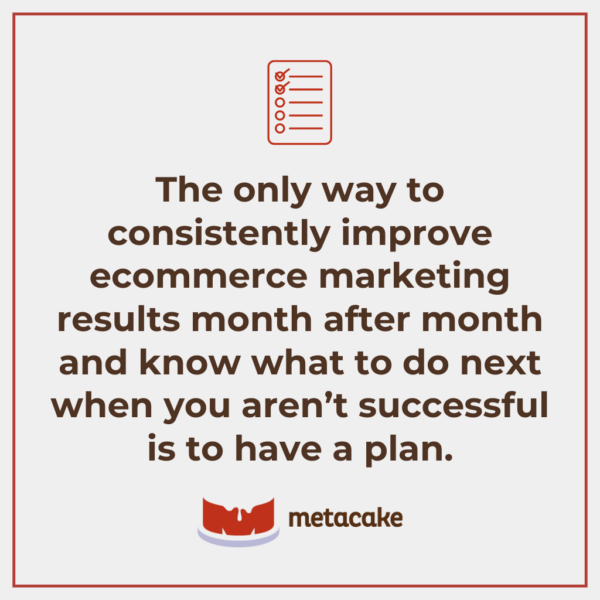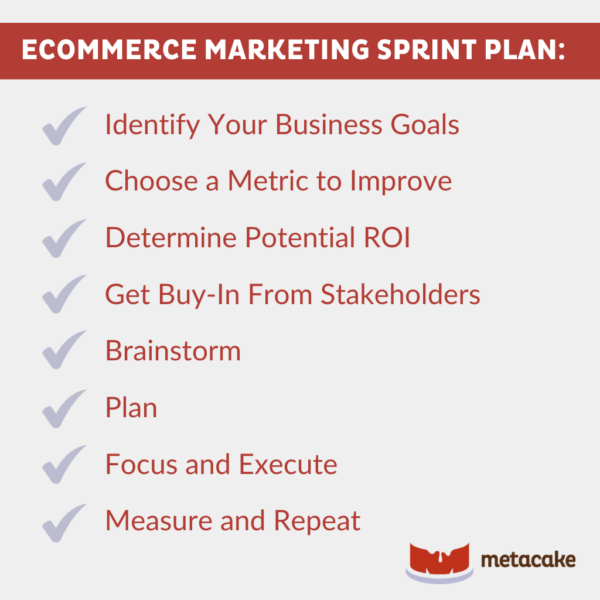
HIT YOUR STRIDE WITH AN ECOMMERCE MARKETING PLAN
One of the most challenging aspects of marketing is sticking to a process of strategic decision-making. And marketing folks aren’t typically known for their attention to detail. They usually thrive with minimal structure and high creativity (or at least they think they do).
The issue with this is that marketing is a science more than anything. The best marketers out there are those who understand this science and develop a plan to systematically and creatively improve their ecommerce marketing.
This is rare, but those are the marketers that predictably improve performance over time, no matter what. And those are the kind of marketers we are at Metacake.
To guarantee constant performance improvement, you need to approach your marketing in a systematic way. When it comes down to it, you need to be more like marketing engineers, listening to data over creative intuition. Use data to benchmark where you are, estimate the upside of improving a certain area, implement creative solutions, and then track your progress as you walk down that path.
In this article, we’ll explain a process that allows you to curate a more focused, data-driven plan for your ecommerce business in order to improve your marketing in a predictable way.
What Does a Plan for Improving Your Ecommerce Marketing Look Like?
Most marketers would pay a lot of money for a guarantee that marketing performance would consistently improve month after month. Fortunately, there’s a method for marketing improvement that simply requires a systematic, disciplined approach to making decisions and implementing them rather than following your gut (which is what most marketers do). This method is what we call a marketing sprint.
How Do You Know if You Need a Marketing Sprint?
Whether your marketing team feels like it’s constantly playing catch-up or you already have some systems in place, you’ll likely benefit from marketing sprints. Let’s look at how you know it’s time to start utilizing them.
1. Your Marketing Isn’t Predictably Successful
Marketing needs to be quantifiable and scalable in order for a brand to move out of the survival stage of business and into the health stage. In order to be quantifiable and scalable, it needs to be predictable. It can’t be a magic black box where you try something new and hope money comes out the other side — you need clear strategies that provide a return more often than not.
2. You Lack a Method for Consistently Improving the Results of Your Marketing
One of the hardest parts about being a marketer is that most of the time, you won’t see great results on the first try. And most marketers have no idea where to go when their idea doesn’t seem to work. The answer to this dilemma is a plan for systematically moving ecommerce marketing performance in the right direction.
3. You Don’t Have a Plan for When Your Gut Feeling Doesn’t Work
Many marketers feel they have a knack for understanding their customers, so they rely on that instinct to create marketing that works. The problem with relying on that gut feeling is when that plan stops working or when you need to scale the strategy.
The only way to consistently improve ecommerce marketing results month after month and know what to do next when you aren’t successful is to have a plan. This is where marketing sprints come in.

The Ecommerce Marketing Sprint
To tackle this issue, we’ve dialed in the idea of the marketing sprint for organizations’ internal marketing teams.
What’s a Marketing Sprint?
The concept of sprints is well-known and has been around for years in the software development world. Simply put, it’s the idea of setting a defined period of time (for example, two weeks), agreeing to what’ll be accomplished in that time, and then focusing on nothing else until it’s done.
What Are the Benefits of an Ecommerce Marketing Sprint Plan?
We’ll dive into a step-by-step plan for an ecommerce marketing sprint below, but let’s quickly run through the benefits first. A marketing sprint provides:
- Clarity on the goal you’re after and what it means to the business
- Clarity on the activities needed to achieve that goal
- A time limit for applying effort to those activities
- A feedback loop to identify what’s working and optimize accordingly
Maybe you’re facing challenges with improving your ecommerce marketing performance, whether that’s in paid advertising, email marketing, or your site’s conversion rate. Or perhaps your team has trouble prioritizing what’s important because everything needs to get done. If any of these scenarios resonate with your team, you need this.

A Plan for Using the Ecommerce Marketing Sprint in Your Business
Let’s dive into the specifics of the ecommerce marketing sprint, one step at a time.
1. Identify Your Business Goals
It’s important to be aware of your overarching business goals for your stage of business growth. Depending on the season you find your brand in, you may want to hit a certain revenue goal by the end of the year, improve your profit margin by a certain amount, or adjust your brand position in the marketplace.
The marketing sprint focuses on a specific goal, but at the end of the day, it’ll contribute to your broader focus. Your business goal will likely inform the metric you decide to focus on improving (in step 2, below).
2. Choose a Metric to Improve
Before you do anything else, you need to know which metrics matter to your business. Make sure you have the right analytics in place to track those correctly.
Once that’s established, choose a single metric to improve on during your sprint. This could be click-through rate, conversion rate, return on ad spend (ROAS), email open rate, etc. Just make sure it somehow contributes to your broader business goal from step one.
The key to a sprint is to take that single metric and improve it in one area of focus. For example, you might want to focus on improving the conversion rate for a certain landing page, increasing the open rate for your promotional emails, or boosting the ROAS on ads for your retargeting audience.
3. Determine Potential ROI
Once you know which metric to improve and where to work on it, determine the potential ROI from accomplishing that goal.
Remember to think of this as micro-improvement as opposed to going after giant goals. You’re not looking to increase store revenue by $10K per month — you’re trying to increase the click-through rate on your ads for abandoned checkouts by X%. If there’s an X% increase in clicks, what’ll that do to the rate of those completing checkout? And what does that mean for your weekly or monthly sales?
The key here is to be specific about what to improve and the ROI that can come from accomplishing it. Based on this, you can determine the benefits of pursuing that goal and how much effort to put into it. Of all the goals you could go after, low-hanging fruit (easy wins) is what to prioritize first.
4. Get Buy-In From Stakeholders
After determining the potential ROI, this is a great opportunity to get stakeholders and other important team members on board with the sprint.
If leaders buy into the goal, it’ll help your team stay focused without being taken off course by other people’s spontaneous ideas for new initiatives. And in the ecommerce marketing world, we all know how often distractions pop up and how easy it is to step away from the plan and get pulled into a new project. Focusing can be the hardest thing, so this step is very important.
5. Brainstorm
Now you’re ready to start tackling this goal! Gather your team and brainstorm every method you possibly can to accomplish this improvement — remember, in a brainstorming session, there are no bad ideas. We really value Tony Robbins’ rapid planning method (RPM) if you’re looking for an efficient way to brainstorm.
6. Plan
After brainstorming, sort all of your ideas based on ease of execution and level of impact. Then identify the top ideas from the brainstorming session that are most likely to succeed and could reasonably be accomplished.
Now decide upon a reasonable timeframe for your marketing sprint. This is typically two weeks, but it could be longer if your ideas require more time to implement. Pick a window that allows enough time to execute your ideas and assess results.
7. Focus and Execute
Now it’s go-time. Delegate tasks to members of your ecommerce marketing team, planning everyone’s day around nothing but implementing your ideas, monitoring, and optimizing in order to achieve this goal. Avoid distractions and other projects as much as possible.
Pro Tip: Other tasks might pop up, but make sure you’re evaluating just how urgent those tasks are. If this comes up often, your organization needs to improve its planning.
A great way to do that is to use an integrated marketing planner to set your calendar and tasks in advance. If you don’t get this down, you’ll spend too much time getting distracted by things that always seem urgent.
For example, if someone on your team remembers Mother’s Day is this weekend and suggests you run a sale, that doesn’t count as an emergency. That’s something that could’ve been planned in advance.
8. Measure and Repeat
Once your sprint period is complete, assess what worked, what didn’t, and why.
You may not have accomplished the goal in your timeframe, and that’s okay. The important part is that your team assesses the effects (or lack of effects) of the changes and testing and then optimizes accordingly.
If you didn’t hit your goal, use this learning to embark on another sprint. If it did work, awesome. It’s time to move onto the next metric that needs improvement.
On Your Mark… Get Set… Sprint!
Ready to give it a try in your business? This plan will systematically improve your ecommerce marketing performance, one step at a time. The key to success is to stay disciplined and remain focused.
This is the beginning of taking your marketing team (and strategy) from chaotic and emergency-focused to scientific and intentional. You won’t regret it.
Get on track with an ecommerce marketing plan that’ll get you across the finish line. Need some encouragement along the way? Our expert team is ready to cheer you on. Reach out today for the support you need to get a good running start.



